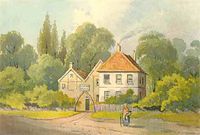Cupid's Garden
CUPID'S GARDEN. English, Country Dance Tune (3/2 time). G Major. Standard tuning (fiddle). AABB. "Cupid's Garden" first appears in print as a longways dance ("for as many as will") in Henry Playford's Dancing Master, 7th edition (1686), and in all subsequent editions of the long-running series through the final, 18th edition of 1728 (then published by John Young in London). Playford also printed it in his Apollo's Banquet, 5th edition, 1687. It also appears in all three volumes of London's Walsh publishing company's Compleat Country Dancing Master (1718, 1731, 1754).
Anne G. Gilchrist, writing in her article "Ancient Orkney Melodies" (JEFDSS, vol. 3, No. 4, Dec. 1939), notes:

Of this [i.e. the untitled Orkney tune identified as a "Cupid's Garden" variant] Colonel Balfour remarks that neither name or words have been left. It is however well known as the tune of the old song "Cupid's Garden"--one of the most generally known of the traditional songs according to Chappell. The title is a corruption--and a pretty one--of Cuper's Gardens, a once famous place of amusement on the Surrey side of the Thams opposite Somerset House. The gardens were opened in 1678, but tune and song are probably of a later date. The gardens were finally closed in 1753. The song generally opens:
'Twas down in Cupid's garden
For pleasure I did go
To see the fairest flowers
That in that garden grow:
The first it was the jessamine,
The lily, pink, and rose,
And surely they're the fairest flowr's
That in that garden grows,
That in that garden grows.
The gardens had originally been opened by Boydell Cuper and had walks, arbors and a bowling green, and, from 1738, musical performances and fireworks displays were featured. The gardens became extremely popular but they also gained a notoriety as 'Cupid's Gardens'.
Printed source: Barlow (The Complete Country Dances from Playford's Dancing Master) 1985; No. 293, p. 72. Barnes (English Country Dance Tunes), 1986.
X:1 T:Cupid's Garden M:6/4 L:1/8 B:Playford - Dancing Master 7th edition (1686) K:Bb F2|B3A B2 c3de2|d2(B4 B4)de|f3g f2A4B2|(c6 c4)F2| B3A B2 f3gf2|g2a2b2 a3gf2|g2c2f2 f4=e2|(f6 f4):| |:f2|f3g f2g4 a2|b2 (d4d4) ed|c2d2B2 A2B2G2|(g6 g4)f2| e2f2e2 c2d2B2|A2B2G2 F4a2|ga b2G2 A4B2|(B6 B4):||
X:2 T:Untitled T:Cupid's Garden O:Orkney M:C L:1/8 R:Air S:Colonel David Balfour B:Anne Gilchrist & E.A. White, "Ancient Orkney Melodies" (JEFDSS, vol. 3, No. 4, Dec. 1939) K:Bb Bc|d2d2B2 cd|e2d2c2 B>c|d2B2G2 FD |E6 BG| F3D B,2B2|c3A F2e2|d2f2e2d2|d2B2G3F|F3G B2B2|B6||
© 1996-2010 Andrew Kuntz. All Rights Reserved.
Engraver Valerio M. Pelliccioni

